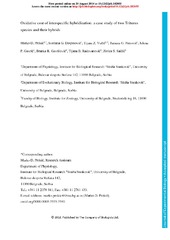Приказ основних података о документу
Oxidative cost of interspecific hybridization: a case study of two Triturus species and their hybrids.
| dc.creator | Prokić, Marko | |
| dc.creator | Despotović, Svetlana | |
| dc.creator | Vučić, Tijana | |
| dc.creator | Petrović, Tamara | |
| dc.creator | Gavrić, Jelena | |
| dc.creator | Gavrilović, Branka | |
| dc.creator | Radovanović, Tijana | |
| dc.creator | Saičić, Zorica | |
| dc.date | 2019-08-20 | |
| dc.date.accessioned | 2018-10-04T10:26:37Z | |
| dc.date.available | 2019-08-20 | |
| dc.date.issued | 2018 | |
| dc.identifier.uri | http://jeb.biologists.org/content/early/2018/08/17/jeb.182055 | |
| dc.identifier.uri | https://radar.ibiss.bg.ac.rs/handle/123456789/3151 | |
| dc.description.abstract | Oxidative stress has most recently been suggested as one of possible mechanisms responsible for reduced fitness of hybrids. To explore possible oxidative cost of hybridization, we examined antioxidant defense system parameters (superoxide dismutase, catalase, glutathione peroxidase, glutathione s-transferase, glutathione reductase, glutathione, SH groups), their interconnectedness (index of integration), and levels of oxidative damage (concentrations of lipid peroxides-TBARS) in lab-reared newt species, Triturus macedonicus and T. ivanbureschi, and their hybrid. Our results showed that parental species differed in antioxidant defense system parameters, but not in the levels of integration of the whole system and oxidative damage. Individuals of T. ivanbureschi had higher activities of superoxide dismutase, glutathione s-transferase and concentrations of glutathione. Hybrid individuals of crested newts displayed higher levels of the antioxidant defense system (higher superoxide dismutase, catalase, glutathione peroxidase activities and concentrations of SH groups), and a lower overall correlation of antioxidant system (lower index of integration) in comparison to both parental species, suggesting that they may possess a less efficient antioxidant defense system and a higher investment in maintaining oxidative balance. The higher investment in the antioxidant system could divert limited resources away from other functions and affect further hybrid fitness. The presented findings contribute to a better understanding of the antioxidant defense system of crested newts and their interspecies differences, and support the hypothesis that oxidative stress is one of the costs of interspecific hybridization. | en |
| dc.relation | info:eu-repo/grantAgreement/MESTD/Basic Research (BR or ON)/173041/RS// | |
| dc.relation | info:eu-repo/grantAgreement/MESTD/Basic Research (BR or ON)/173043/RS// | |
| dc.rights | embargoedAccess | |
| dc.source | The Journal of Experimental Biology | |
| dc.subject | Antioxidative defense system | |
| dc.subject | Crested newts | |
| dc.subject | Interspecific hybridization | |
| dc.subject | Oxidative stress | |
| dc.subject | Triturus | |
| dc.title | Oxidative cost of interspecific hybridization: a case study of two Triturus species and their hybrids. | en |
| dc.type | article | en |
| dc.rights.license | ARR | |
| dcterms.abstract | Радовановић, Тијана; Деспотовић, Светлана; Вучић, Тијана; Петровић, Тамара; Гаврић, Јелена; Гавриловић, Бранка; Прокић, Марко; Саичић, Зорица С; | |
| dc.rights.holder | © 2018. Published by The Company of Biologists Ltd | |
| dc.identifier.doi | 10.1242/jeb.182055 | |
| dc.identifier.pmid | 30127083 | |
| dc.identifier.scopus | 2-s2.0-85054458075 | |
| dc.identifier.wos | 000447340900012 | |
| dc.citation.apa | Prokić, M. D., Despotović, S. G., Vučić, T. Z., Petrović, T. G., Gavrić, J. P., Gavrilović, B. R., … Saičić, Z. S. (2018). Oxidative cost of interspecific hybridization: a case study of two Triturus species and their hybrids. The Journal of Experimental Biology, DOI:10.1242/jeb.182055. | |
| dc.citation.vancouver | Prokić MD, Despotović SG, Vučić TZ, Petrović TG, Gavrić JP, Gavrilović BR, Radovanović TB, Saičić ZS. Oxidative cost of interspecific hybridization: a case study of two Triturus species and their hybrids. J Exp Biol. 2018;DOI:10.1242/jeb.182055. | |
| dc.type.version | acceptedVersion | |
| dc.identifier.fulltext | https://radar.ibiss.bg.ac.rs/bitstream/id/4509/JExpBiol_2018.pdf | |
| dc.citation.rank | M21 |

